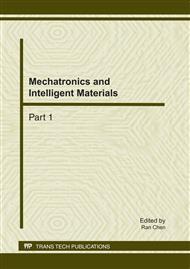[1]
W. Jiang, Y. Yuan: Campus Guidance System Based on ComGIS, Geospatial Information, No. 5, (2006).
Google Scholar
[2]
H. Liu, H. Darabi, P. Banerjee, and J. Liu: Survey of Wireless Indoor Positioning Techniques and Systems, IEEE Transaction on Systems, Man, and Cybernetics, Vol. 37, No. 6, pp.1067-1080, (2007).
DOI: 10.1109/tsmcc.2007.905750
Google Scholar
[3]
P.K. Engee: The Global Positioning System: Signals, measurements, and performance, International Journal Wireless Information Networks, Vol. 1, No. 2, pp.83-105, (1994).
Google Scholar
[4]
L.M. N.Y. Liu Y.C. Lau, and A.P. Patil: LANDMARC: Indoor location sensing using active RFID, Wireless Network, Vol. 10, No. 6, pp.701-710, (2004).
DOI: 10.1023/b:wine.0000044029.06344.dd
Google Scholar
[5]
T. Roos, P. Myllymaki, H. Tirri, P. Misikangas, and J. Sievanan: A probabilistic approach to WLAN user location estimation, International Journal Wireless Information Networks, Vol. 9, No. 3, pp.155-164, (2002).
DOI: 10.1023/a:1016003126882
Google Scholar
[6]
3GPP Technical Specification Group (TSG) Services and System Aspects, TS 22. 071, Location Services (LCS); Service description; Stage 1 (Release 9), version 9. 1. 0, (2010).
Google Scholar
[7]
Open Mobile Alliance: Secure User Plane Location V2. 0 Enabler Release Package; http: /member. openmobilealliance. org/ftp/Public_documents/LOC/Permanent_documents/OMA-ERP-SUPL-V2_0-20080627-C. zip.
Google Scholar
[8]
D. Niculescu and B. Nath. Ad Hoc Positioning System (APS) Using AOA. In IEEE INFOCOM, Vol. 3, pp.1734-1743, (2003).
DOI: 10.1109/infcom.2003.1209196
Google Scholar
[9]
M. Addlesee, R. Curwen, S. Hodges, J. Newman, P. Steggles, A. Ward, and A. Hopper: Implementing a Sentient Computing System. Computer, Vol. 34, No. 8, pp.50-56, (2001).
DOI: 10.1109/2.940013
Google Scholar
[10]
A. Savvides, C.C. Han, and M.B. Strivastava: Dynamic Fine-Grained Localization in Ad-Hoc Networks of Sensors. In ACM/IEEE MOBICOM, pp.166-179, (2001).
DOI: 10.1145/381677.381693
Google Scholar
[11]
S.P. Kuo, S.C. Lin, B.J. Wu, Y.C. Tseng, and C.C. Shen: GeoAds: A Middleware Architecture for Music Service with Location-Aware Advertisement. In IEEE International Conference on Mobile Ad-hoc and Sensor Systems, (2007).
DOI: 10.1109/mobhoc.2007.4428699
Google Scholar
[12]
J.J. Pan, J.T. Kwok, Q. Yang, and Y. Chen: Multidimensional Vector Regression for Accurate and Low-Cost Location Estimation in Pervasive Computing. IEEE Transactions on Knowledge and Data Engineering, Vol. 18, No. 9, pp.1181-1193, (2006).
DOI: 10.1109/tkde.2006.145
Google Scholar
[13]
S.A. Dudani: The distance-weighted k-nearest-neighbor rule. IEEE Transactions on Systems, Man and Cybernetics, Vol. 6, No. 4, pp.325-327, (1975).
DOI: 10.1109/tsmc.1976.5408784
Google Scholar
[14]
J. Han and M. Kamber: Data mining: concepts and techniques, second edition, Morgan Kaufmann Publishers, (2005).
Google Scholar


